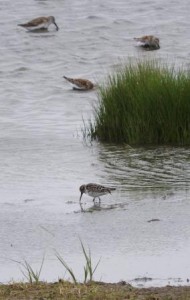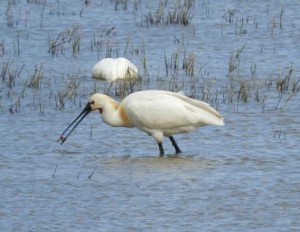Norfolk Weekend 13-15th May
A total of fifteen of us went on the weekend trip to Norfolk, six of us setting off on Friday morning and going via Whisby and Frampton Marsh to meet up with the other nine who were already there having been on the RSPB’s midweek trip to Suffolk first.

Those who went to Whisby were treated to close views of a showy Nightingale in full song (along with two others heard), and a good selection of more common migrants including Garden Warbler, Whitethroat and Blackcap. On then to Frampton where Rob made the fortunate decision to check what was about before having lunch – to discover that a Broad-billed Sandpiper, Little Stint, Temminck’s Stint and Curlew Sandpiper had all turned up and were feeding in with a flock of Dunlin at the far end of the reserve! Forgoing lunch, Rob and I hot-footed it to the sea bank and, despite the high winds and unseasonably cold weather conditions, managed to find all the above. Though increasingly flighty, apart from the Curlew Sandpiper which disappeared, they all stayed about long enough for the other four to catch up with them as well. A single Knot, two Pink-footed Geese and a huge flock of Brent Geese were slightly unexpected too.
Hearing that a flock of 24 Dotterel was at Choseley Drying Barns close to Titchwell, the decision was made to try for those on Friday evening, instead of spending any longer at Frampton. In increasingly cold and windy conditions, we made our way there and failed to see them! However, our Norfolk list got off to a good start anyway with Corn Bunting and Turtle Dove showing well.
Everyone met up at Heacham Manor Hotel in time for dinner, to discover that most of those who had come from Suffolk had managed to see the Dotterel earlier in the day! A Barn Owl entertained us from the dining room at dusk.
On Saturday, some of us had an early start before breakfast to visit the Wolferton Triangle. Setting off at 6.30am we arrived there in time to hear Golden Pheasant, but they remained frustratingly out of sight. However, one lucky car-full did get lots of sightings of Muntjac deer, one of which then obligingly scared up a Golden Pheasant which walked rapidly and silently across the glade and disappeared (never to be seen again!) A fleeting view, but worth it.
In cold and windy, though relatively bright, conditions, we all set off after breakfast to try for the Dotterel again – this time with more success, although they were distant and it was difficult to hold the ‘scopes steady in the wind. The whole flock eventually flew up and landed together and 25 birds were counted then. We moved on to Cley where we spent several hours; first visiting the three hides in the reed beds, then walking up the west bank to the car park by the shingle bank, walking along the shingle (sea watching wasn’t much of a proposition given the strong winds and heavy sea) and then back down East Bank, stopping at the new hide overlooking Arnold’s Marsh for a while. It was quite a shock to see just how much the 2013 storm surge reduced the height of the shingle bank, sweeping the shingle onto the reserve.

Despite the chill and a squally shower (just when there was no shelter near) there was enough about to keep us all going – including Avocets, loads of Swifts, Greenshank, Reed Warbler, Water Rail, Little Ringed Plover, Gannet and Fulmar over the sea, Little Tern, Sandwich Tern, one Wheatear, Brent Geese, Little Stint, Marsh Harrier, Bar-tailed Godwit and best of all, as we walked back along East Bank, a striking white-headed Ruff and two Spoonbills which dropped in to feed.
After that, everyone made their way to Titchwell, either directly or via places such as Burnham Norton. Other birds added to the list before the end of the day included Cetti’s Warbler, Common Tern, Lesser Whitethroat, Common Sandpiper, Curlew and Bearded Tit – the total for the day being in the region of 90 species (though some had already been seen the day before too).
On Sunday, there was another early start for some, back to Wolferton (Scissors car park) for a walk through the woodland to look over Dersingham Bog. Green Woodpecker, a pair of Stonechats, Jay, Treecreeper, Nuthatch and a Woodlark doing a display flight made for another good start to the day marred only by one car getting lost en route – though they did make it back for breakfast! In bright sunny weather and much calmer, warmer conditions, the morning was spent at Titchwell where Red-crested Pochard, Bearded Tits, Little Stint, a rather distant Temminck’s Stint, Hobby and a very scruffy Red Kite were added. Good views of Cetti’s Warbler were had by some and lucky Liz and Keith also saw an Otter swimming across one of the channels in the reeds.
Most of us drove home from Norfolk via Frampton, which was a good decision as we ended the trip with Black-tailed Godwit, three Little Gulls and in lovely afternoon light and calm conditions had good views of Wood Sandpiper, Ruff in lots of different plumage variations, Lesser Whitethroat and male Garganey.
In total we saw about 110 species in Norfolk and 12 more in Lincolnshire (at Whisby and Frampton Marsh).
Many thanks to Peter Watson for organising it all. A most enjoyable weekend.
Jane Chapman
